Key takeaways:
- Time blocking enhances productivity by promoting focused work periods, mental clarity, and accountability.
- Preparation involves understanding personal energy rhythms, identifying priorities, and committing to the schedule as appointments.
- Flexibility is crucial; adjust blocks and incorporate buffer time to accommodate unexpected tasks and energy fluctuations.
- Success measurement includes tracking completed tasks, observing energy levels, and assessing the quality of work produced.
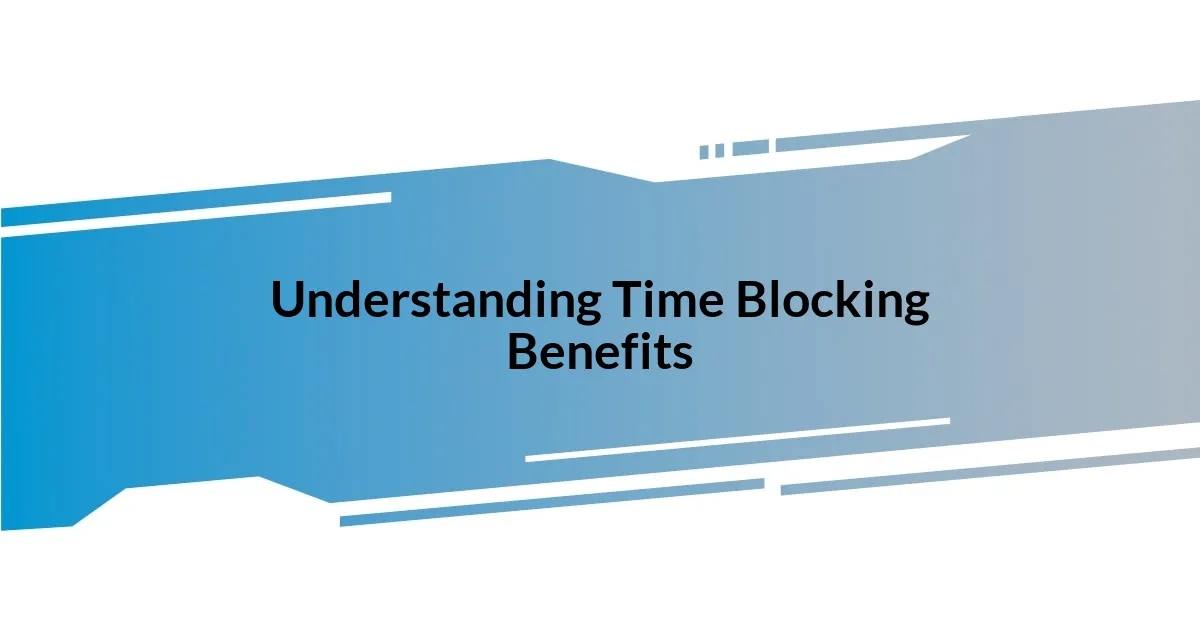
Understanding Time Blocking Benefits
Time blocking has transformed my productivity in ways I never anticipated. Once, I struggled to manage my day effectively, often feeling overwhelmed by a never-ending to-do list. After embracing time blocking, I discovered the power of focused work periods; I could finally allocate specific times to tasks, leaving less room for distractions and procrastination.
One of the most compelling benefits I’ve experienced is the mental clarity that comes with time blocking. When I set aside dedicated time for deep work, it’s as if a fog lifts. I remember feeling a sense of relief when I realized that I could actually finish my tasks without the constant burden of multitasking. Have you ever felt like you’re spinning your wheels, making little progress? It’s a frustrating place to be, and time blocking can lighten that load significantly.
Additionally, I’ve found that this method fosters accountability. By scheduling my tasks, I’m making a commitment to myself. There’s a certain pride in checking off items on my list during my designated blocks, and when I stick to my schedule, it’s genuinely gratifying. Have you ever felt that rush of accomplishment after completing a task? With time blocking, that feeling becomes a regular part of my routine, motivating me to keep pushing forward.
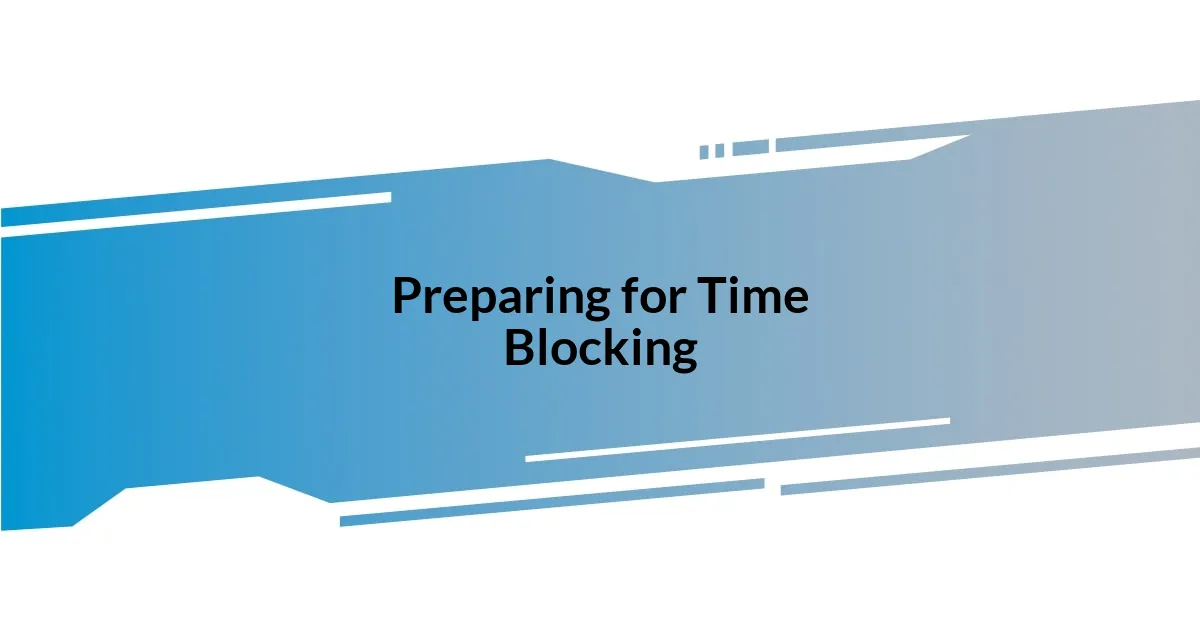
Preparing for Time Blocking
Preparing for time blocking requires a bit of introspection and planning. I found that understanding my own rhythms was vital. Reflecting on when I felt most energized and productive helped me shape my blocks accordingly. For example, I discovered that I’m much sharper in the morning, so I reserved that time for tasks requiring deep focus, like writing or strategic planning.
To get started with time blocking, here are some essential steps you might consider:
- Identify Your Priorities: List your most important tasks and deadlines to clarify your focus.
- Assess Your Energy Levels: Take note of when you feel most alert and motivated throughout the day.
- Create a Template: Draft a weekly schedule that includes set blocks for both work and breaks, ensuring balance and flexibility.
- Gather Necessary Tools: Use planners, digital calendars, or apps that suit your style to streamline your blocks.
- Stay Committed: Make a commitment to honor your blocks, treating them as appointments to enhance your accountability.
These steps helped me craft a structure that not only supports my productivity but also aligns with my personal tendencies. I found that the emotional boost from sticking to my blocks was incredibly satisfying.

Setting Up Your Time Blocks
Setting up your time blocks begins with establishing a clear plan. What I found helpful was visualizing my week; I used a whiteboard to map out the time slots for my tasks. This method made it tangible and allowed me to see how everything fit together. It felt rewarding to create that visual representation; seeing my week laid out helped reduce anxiety about what lay ahead.
Another valuable aspect is defining the purpose of each block. I learned the hard way that not all tasks are created equal; some require intense concentration, while others lend themselves to more casual engagement. I started labeling my time blocks with codes: “Deep Work” for high-focus tasks and “Catch Up” for lighter, administrative duties. This clear categorization helped me stay on track while also honoring my varying energy levels throughout the day. It was like giving each task its own personality.
Lastly, be flexible in your approach, and don’t hesitate to adjust as needed. There will be days when unexpected tasks arise, and that’s completely normal. I recall a week when a last-minute meeting disrupted my blocks. Instead of getting frustrated, I simply shifted my remaining tasks around, allowing myself to adapt without losing momentum. That adaptability turned out to be a game-changer in maintaining my overall productivity.
| Block Type | Description |
|---|---|
| Deep Work | Uninterrupted focus on challenging tasks. |
| Catch Up | Light duties like emails and administrative tasks. |
| Break | Time for rest and recharging. |
| Planning | Reviewing next tasks and organizing priorities. |
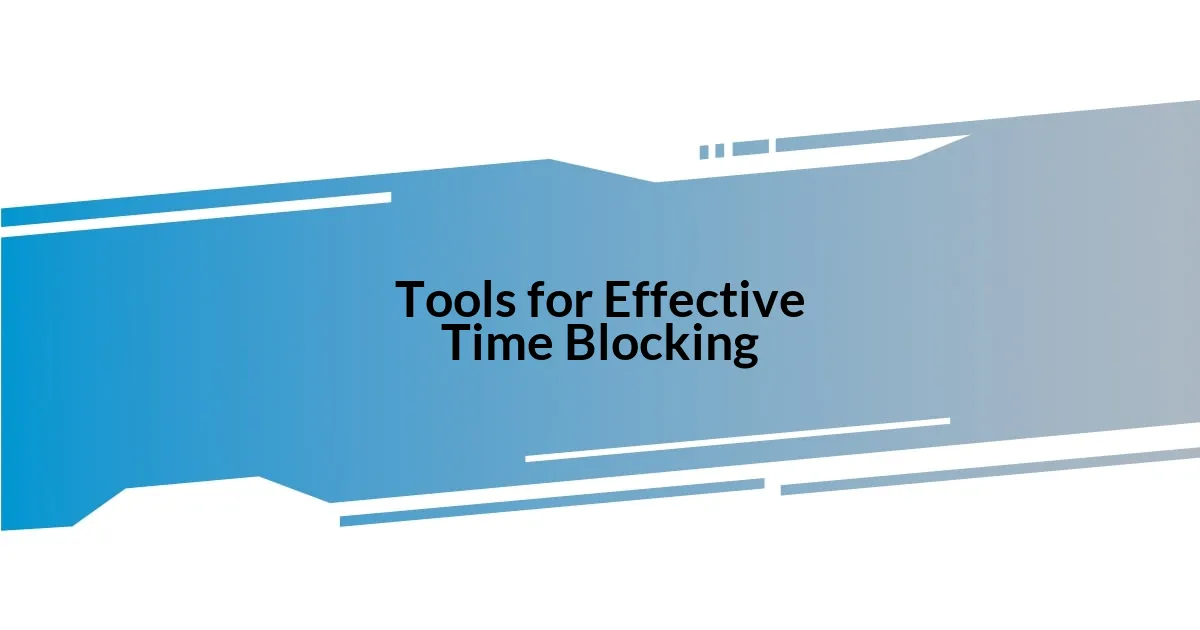
Tools for Effective Time Blocking
One of the key tools I’ve found indispensable for effective time blocking is my digital calendar. Initially, I thought it was just a glorified to-do list, but over time, it became my trusted ally. I remember the first time I color-coded my blocks; each hue represented different types of work. It was enlightening to see how my time was allocated, and it made me more aware of any imbalances. Have you ever felt like some tasks take up all your time? Using color-coding not only brought clarity but also helped me prioritize better.
In addition to a digital calendar, I began using a simple timer during my focused blocks. I set it for 25 minutes and just focused on my task. When the timer went off, I’d take a short break. This technique, often called the Pomodoro Technique, has transformed the way I tackle my workload. I found that breaking my tasks into manageable intervals keeps me engaged and less overwhelmed. It’s funny how something as simple as a timer can change your perspective on productivity, right?
Lastly, I’ve embraced task management apps, which are a game changer for organizing my day. As someone who used to jot tasks down on sticky notes, I can now consolidate everything in one place. These apps allow me to drag and drop tasks into specific blocks seamlessly. I still recall the sense of control I felt when I first transitioned from scattered notes to an organized digital space. It’s empowering to see my tasks lined up, ready for execution!

Overcoming Time Blocking Challenges
I’ve encountered my fair share of challenges with time blocking, but I’ve learned how to tackle them effectively. For instance, there was a period when I struggled with distractions. I remember sitting down to work, only to be sidetracked by notifications or the lure of social media. To combat this, I created a designated ‘distraction-free zone.’ By turning off notifications and setting my phone to Do Not Disturb, I could dive into my deep work periods without interruption. Have you ever noticed how much clearer your mind feels in a focused environment? It really made a difference for me.
Another challenge is the initial overwhelm of planning my blocks. There was a time when I found myself staring at my empty calendar, unsure how to fill it. I realized that breaking my tasks into smaller steps was key. Instead of planning an entire project in one block, I now dedicate blocks for research, brainstorming, and drafting separately. This approach not only feels more manageable but also turns daunting tasks into bite-sized pieces. When was the last time you tried breaking a task into smaller parts? I can promise that tackling them one at a time feels incredibly satisfying.
Lastly, sticking to my planned blocks can sometimes feel like an uphill battle. I distinctly remember a week where every planned session went awry due to unforeseen tasks. At first, I felt defeated, but then I learned to view adjustments as a vital part of the process. Instead of rigidly sticking to my blocks, I began treating them as guidelines that allowed for flexibility. Adopting this mindset shift has been liberating. Have you ever felt guilty for not sticking rigidly to your plan? Trust me, embracing flexibility has led me to greater productivity and reduced stress.
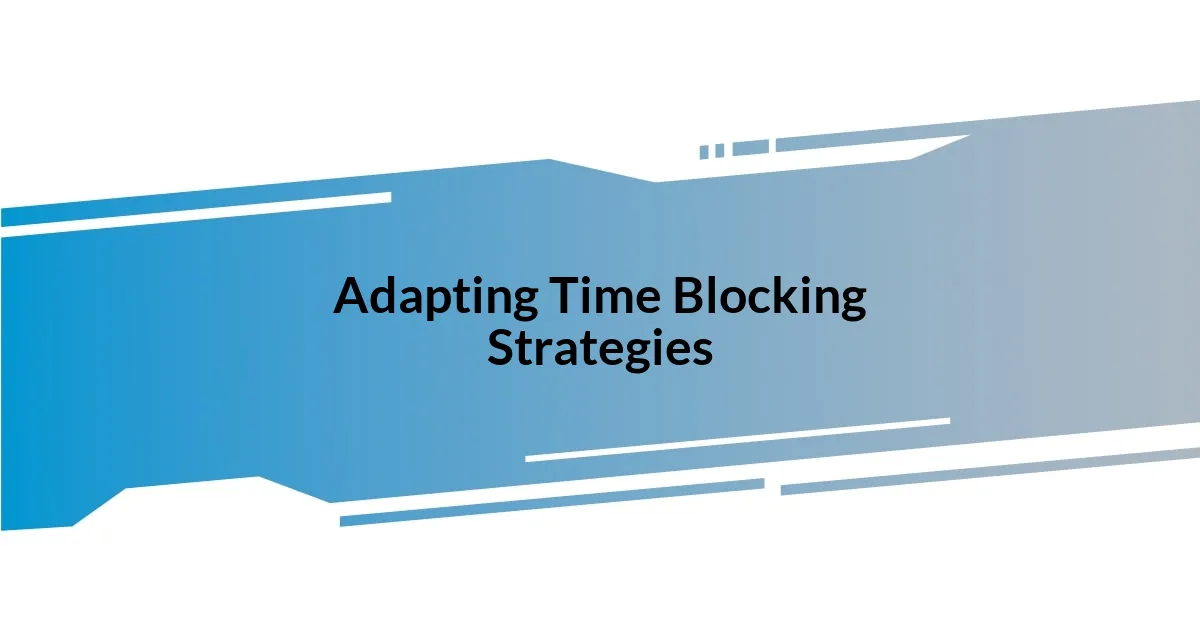
Adapting Time Blocking Strategies
Adapting time blocking strategies is essential for making the technique work for you. For instance, when I first started, I had a rigid schedule that I thought would bring me efficiency. However, I quickly discovered that life happens—emergencies come up, and tasks take longer than expected. I learned to incorporate buffer time between blocks, which allowed me to breathe and adjust without feeling overwhelmed. Have you ever felt like you’re in a race against time? Building in those pauses really turned my day around.
I also found it helpful to reevaluate my time blocks periodically. There were days when my energy levels fluctuated significantly. I remember one week where my morning blocks were quite unproductive, leaving me frustrated and exhausted by noon. So, I experimented with shifting my most demanding tasks to the afternoons, when I tend to be more alert and energized. Have you considered how your natural rhythms might affect your productivity? This simple adjustment made my workflow so much better.
Lastly, I began to tailor my blocks based on the types of tasks I had, aligning them with what I felt most inspired to work on at any given time. During phases of creative work, I allowed for longer unbroken hours to let my ideas flow freely. Conversely, when tackling mundane tasks, shorter blocks with frequent breaks worked wonders for my focus. It’s fascinating how understanding my unique rhythm enhanced my time blocking experience. Do you usually follow your intuition about when to best tackle certain activities? Trusting that instinct can be a game changer.
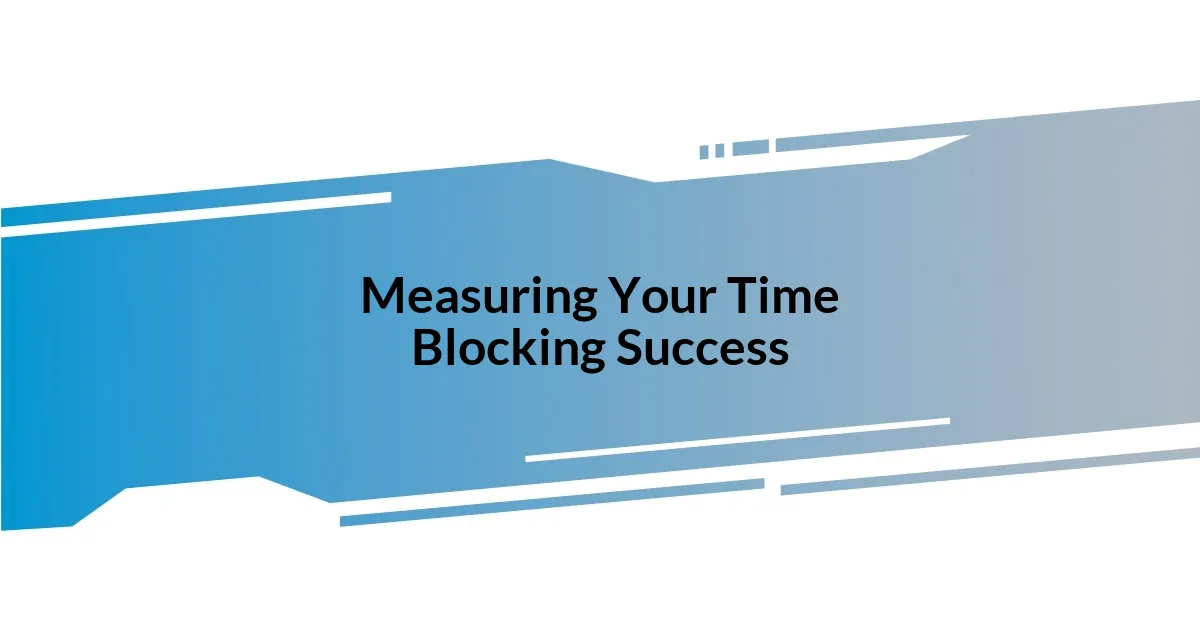
Measuring Your Time Blocking Success
Measuring the success of your time blocking begins with tracking your completed tasks versus your planned blocks. Early on, I started using a simple checklist, marking off what I accomplished each day. There were days when I would look back and realize I achieved far more than I anticipated, which was an incredible confidence boost. Have you ever taken a moment to reflect on your progress? It can be so motivating!
Another way to gauge your effectiveness is by observing your energy levels throughout the day. I remember one particularly hectic week when I felt drained by midday. By reviewing my blocked hours, I noticed that I had scheduled my most challenging tasks during my typical slump. This discovery prompted me to redesign my schedule, placing heavier cognitive load tasks at times when I felt most energetic. Have you thought about how your body’s natural rhythms can affect your productivity? Finding harmony with your energy can be transformative.
Lastly, I often assess the quality of my work. It’s not just about crossing items off a list; it’s about the satisfaction of accomplishing meaningful output. One evening, after a day filled with time blocks that aligned with my most creative periods, I felt a profound sense of achievement. The ideas flowed effortlessly, resulting in high-quality work. Do you measure success only by the number of tasks completed or the impact of those tasks? Shifting your perception to value the quality of your outputs can significantly enhance your time blocking experience.